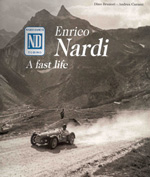
Enrico Nardi, A fast life
By Dino Brunori-Andrea Curami
Fondazione Negri, Brescia 2009
ISBN 88-80108-17-7
Hardbound, 198 pages, B&W and color
82.00 USD
Illustrations below by Attilio Cariati,
by permission of Nardi-Personal Spa
Review by Pete Vack
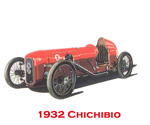
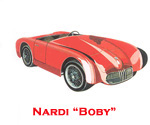
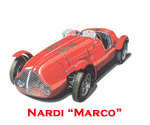
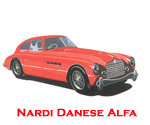
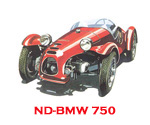
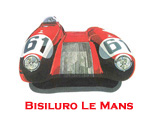
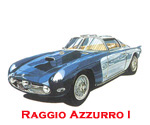
Enrico Nardi would probably be bemused at the attention he continues to receive some 43 years after his death in 1966. More at home in the shop than in social situations, money, fame, or gold watches did not impress him much. One day, a well-dressed foreigner arrived at Nardi’s tiny garage in Turin, condescendingly asking a mechanic in coveralls to speak to the master.
The mechanic sent him into the boss’s office, where Pal, the shop’s Alsatian watchdog was sitting, and the mechanic locked the growling dog with the visitor. Nardi told his employees to “let the master educate this chap,” and left the terrified visitor for a half an hour before unlocking the door. The mechanic, of course, was Nardi himself. A born practical joker, he took his daughter Roberta to the Paris Exhibition but told everyone that the beautiful young girl was his fiancé, which was news to those who knew Nardi as a married man.

Roberta Nardi herself was surprised by the fact that there still was someone interested in her father. Author Dino Brunori met her a year before her death in 2006 and found her very eager to help. “She didn’t have a great deal of material, but she told me several facts about her father’s life and gave me a few pictures of the young Enrico, which appear in the book.”
Brunori puts together enough anecdotes about Nardi to allow the reader to get a fair grasp on what made Nardi—and his products—famous, literally getting Enrico Nardi out from behind the legendary steering wheel. He depends a great deal on interviews with old Nardi veterans Gino Munaron (who died last year) and Gino Velanzano to provide background information. Nardi was, Brunori writes, “meticulous, stubborn, quarrelsome, hot tempered but also courageous.”

Famed as he was for accessories and in particular, steering wheels, Enrico Nardi was also the driving force behind some sixty unique racing cars, sports, grand touring cars, formula cars and showcars. Brunori covers just about every one, and reveals Nardi’s relationship with both Vincenzo Lancia and Enzo Ferrari before the war. Weaving Enrico’s sparkling personality between the cars he helped create, Brunori tracks down the successes drivers achieved while racing NDs—Nardi-Danese cars. It is the fascinating and human story of one of Italy’s postwar “miracles.” It has a precedent, for in 1987, Franco Varisco published a slim volume about Nardi, “Nardi, A story of cars and steering wheels”, but Brunori’s new book is in an entirely different league.

Some readers and fussy old historians want to have their books like a fast food chain—close by, their way and instant fact-gratification. But Brunori (interviewed via email) is the first to admit he is neither a writer nor a historian. “I’m an architect and run a small retail design firm. ‘Enrico Nardi’ is my first (and probably last) work. Only passion drove my efforts,” he wrote. In fact he asked famed Italian historian Andrea Curami to help with the material and get the book completed.
The result is a passionate story, in roughly chronological order. But if you want to know what happened to, for example, Nardi’s first car, nicknamed “Boby” for his daughter, you will find reference to it on page 30 which corresponds to the year 1947. The next mention of Boby is on page 94, when in 1951 Boby was converted to a Giaur by way of Taraschi. In 1952, on page 106, we find the now Crosley powered car in the hands of Frank Dominianni. It all makes perfect sense if read chronologically, and in fact is a joy to read through. But without an index it makes life a bit difficult at times, and alas, there is no index.

Yes, of course we asked. The major issue, according to Brunori, was that the publisher limited the number of pages to 200. Something inevitably has to give, and it was footnotes and a good index as well. There are two versions of the book, one in English and the other in Italian, and that also made it difficult to accommodate and translate footnote and index material. Does this matter? Academically yes, realistically no, for if you like the subject matter and Etceterinis in general, you will buy this book, and probably love it. We did. There is, however a remarkable compendium of races in which Nardi cars participated in after WWII. The date of the race, the name, the class, model, chassis number, car number in the event, driver and co-driver and the finishing position are all listed, from 1947 to 1957. It is a wealth of information and most welcome.

Having a full English version is also very welcome. It is for the most part, very well done. We’d be picky but it is so refreshing to get an all-English edition we refuse to have anything but praise for the effort. We also noted that either the author or translator exhibited a rare sense of humor which was appropriate and enjoyable. But was it intentional or were we reading between the lines? So we asked Brunori, lest we make hasty assumptions. “You are correct. I wrote that way and asked Paul Etgart to translate it literally word by word and not to adapt the Italian to some sort of academic English. I feel he matched my request perfectly.” Good going, Dino.

For the chassis information, John de Boer came to the rescue. We see his fine hand and mind as the book tries to sort out the various Nardi cars and how they were numbered. “Without his help the history of Nardi cars in the USA would still be full of question marks. He was a cornerstone in my work. We met a couple of times in the last few years and we mutually benefited from each other work, sharing our researches. Last April he was here for four days and he revised the work, suggested some changes and amendments.” There were others, such as Cliff Reuter, who were glad to help and their names are in the front of the book. Once the book is more widely distributed, more information will no doubt surface, particularly about the American side of Nardi.
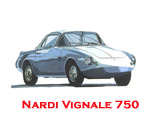
After 198 interesting pages full of unpublished photos, descriptions, ads, and race statistics, Brunori divulges a tragic fact—in the 1970s, the Nardi family pulled out of the business entirely, and the new owners threw almost everything away. “Drawings, records, pictures, documents, spare parts—throw them away! Anything anyone wants something is welcome to take it, the rest will go in the garbage bin.” Fortunately, there are guys like Brunori around, who sought out what was left and saved it. He now has a large part of the original Nardi archive; company books, factory registers, original drawings, documents, dozen of letters and about 700 pictures which served as the basis for his remarkable book. “Nardi, A fast life”, is indispensible for the Italian car enthusiast and a true Gottahave.
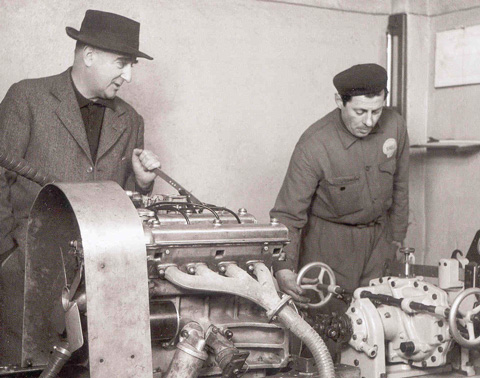
Ernrico Nardi, at home. The year, 1961, the engine, a 1300 Alfa normale.
Did I miss something relevant ? What about the Nardi cnversion kits (for Lancias) much in the style of Abarth (for FIATs) ?
Nardi’s newest ‘wheel’ with pivoting handles: everything old is new again. I tried to order a similar device for my ’53 Lincoln convertible from an article in Popular Science, Popular Mechanix–oneof those mags. I never got an answer back from the company. It differed in that it had the grips inside full rings. Also in that issue was a modification for your outboard motor that put the prop in front of the vertical driveshaft housing–must’ve been promoted by propeller manufacturers. And ah, for the REAL J.C.Whitney catalogs of yore….
Simply awesome Nardi issue, Pete. His cars were among the most charismatic of their era.
I visited the Nardi shop in 1958 and photographed its contents, which included much rare and peculiar Lancia material that he had rescured from the works.
I’d love to have the full story on the Fina Nardi-Alfa. I remember seeing it at Fina’s New York shop when I picked up my Fina ‘muffler’ for my TC. This was a great aluminum device that had a straight-through central passage with a cockpit-operated butterfly valve and two side branches packed with steel wool!
Great review. My friend and former engine builder Don Baldocchi has not one but two of the Frua 750 cars that have been extensively vintage raced and I’m sure he will love the book…and I’m sure I’ll snatch it from him first chance I get.
John deBoer has been a longtime friend and mentor in regard to etceterinis in general and Siatas, including my own 300BC, for more decades than I want to remember. And I am about to add Cliff Reuter, Michele Bandini, and the rest of the group coming to Amelia to my circle of face-to-face friends who I have known for years through the HMod Yahoo Group site.
Great book, great review!
I visited the Nardi shop with Jack Gordon in 1959. The man himself sold us Nardi
steering wheels for my Porsche and Jack’s Alfa. I also bought a set of 3-eared Borrani knock-offs for my Porsche. Signor Nardi told me to wait till I got back to the US before I put them on ’cause they were not legal in Germany. He also tried to sell me a set of Borrani wire wheels for my Porsche, but I was strapped for money then.
I also remember the Nardi Danese that Perry Fina had in New York back in the early ’50s.
i love the pose nardi is taking with the valve spring reliever in his hand as tho he’s doing somthing with it.the valve covers are on the head sir,so you can put that tool down.
you can not better the true history and art of the itaian motor .
Great book recommendation = ) I think its easily one of my favorites… yeah of course because its about Enrico!
NARDI FREDERIC: NARDI 1000 GT. TUYAU DE CHEMINEE POELE BOIS 150 MM. TUYAU DE CHEMINEE POELE BOIS 150 MM. TUYAU DE CHEMINEE POELE BOIS 150 MM. FREDERIC NARDI